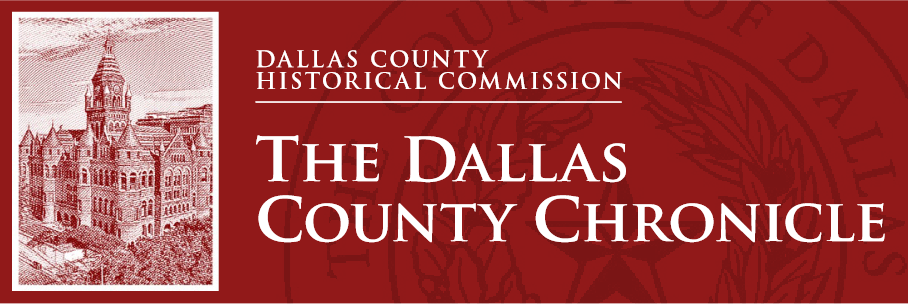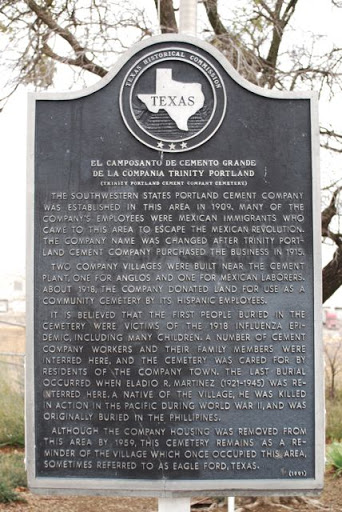Forgotten Community of Cemento Grande

This article has been reprinted with permission from the Dallas County Historical Commission. The article was originally published in the Dallas County Chronicle, Volume 15, Issue 1, Fall 2016, page 1.

It is difficult to get to, locked behind the gates of the large AT&T facility on Cockrell Hill Road, but a request at the gate will, after a few minutes to find someone who knows what you are asking about, gain you admission to the hallowed ground of a cemetery which is the last physical vestige of an Hispanic community that thrived nearby for over forty years. The community, Cemento Grande, was the company town for Mexican immigrant laborers of Trinity Portland Cement. The cemetery commemorates the life of that community, and the hundreds of people who lived and worked there.
In 1907, William Foster Cowan and Associates acquired the land in this area for its rich deposits of limestone and schist. They founded the Southwestern States Portland Cement Company, built a plant, and began supplying the cement for the fast expanding city of Dallas. By 1915, the company had become Trinity Cement and had plants in Dallas, Ft. Worth and Houston. Its products were sold in every adjoining state as well as in Mississippi. Needing workers, but remote from Dallas (which was about four miles to the east) and cut off from public transportation, the company built two villages for its laborers, one for Anglo workers and one for Hispanic workers (almost all of which were immigrants from Mexico). The Hispanic company town, Cemento Grande, only had dirt roads and frame houses with outdoor plumbing. The houses, of various sizes, rented for two dollars a month per room. Many of the first residents came fleeing the horrors of the Mexican Revolution. Others followed for jobs and to be with family. One area of Mexico, in particular, the state of Guanajuto (and for many, the city of San Felipe within that state), was the starting point for many of the community’s new residents.
Around 1918, the company donated land to be used for a cemetery by its Hispanic employees. In all probability the first people buried there were victims of the devastating 1918 influenza epidemic. Through the years, it is estimated that over 200 individuals are buried here. The last burial occurred in 1946 when Eladio R. Martinez was reinterred in the cemetery. Martinez, a native of Cemento Grande, was killed in action in the Pacific during World War II and was originally buried in the Philippines.
Mr. Martinez’s brother, Henry, is perhaps one of the last living natives of Cemento Grande. Now 88 years old, he has dedicated the past fifty years to preserving the cemetery and the memory of the community in which he was born. His family’s history is surely representative of that of many others: His father, Jose, came from San Felipe Guanajuto in 1910 and worked and lived in the community for fifty years. In the cemetery are the graves of his mother, his sister, his uncle, and his brother Eladio.

Henry has outlived them all—including the community itself which was closed and demolished by the company around 1959 with many of its residents relocating a mile or so farther north to the Eagle Ford area of Dallas. Now he alone in his family is left to ensure that neither the community nor the sacred field of the cemetery are lost and forgotten.
Today, a walk through the cemetery reveals faded tombstones, cement crosses askew, and rusty fences. Many of the headstones and crosses were made using materials from the cement company with the names and dates often being etched by hand into the cement while it was still wet.
There is also a Texas Historical Marker and a striking stone memorial to those from the community, almost all of Mexican birth or Hispanic descent, who served this country in war, particularly World War II. While Cemento Grande itself is no more, El Camposanto de Cemento Grande remains as a reminder of the community that once was and serves as a tribute to the lives that were lived there.
How to Get There: The Trinity Portland Cemetery (Cemento Grande) is known by several names, including Trinity Portland Cement Mexican Cemetery, Trinity Portland Mexican Cemetery, Mexican Cemetery and Eagle Ford.
Cemento Grande is located off Cockrell Road south of IH 30 behind A&T building in Dallas and is fully fenced and maintained. You must go through AT&T security check point to reach it.
The cemetery has one Texas State Historical Marker:
El Camposanto de Cemento Grande de la Compania Trinity Portland.
Established: 1924
